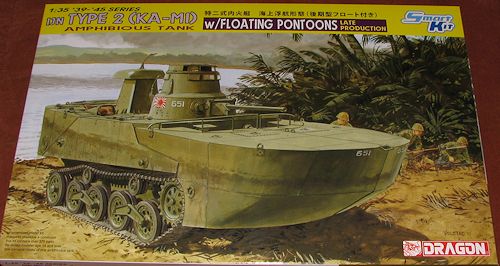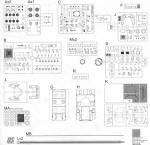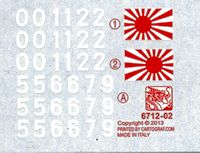
Dragon 1/35 Type 2 amphibious tank with pontoons (late)
| KIT #: | 6712 |
| PRICE: | $73.50 |
| DECALS: | Many options |
| REVIEWER: | Scott Van Aken |
| NOTES: | Smart Kit |

| HISTORY |
As early as 1928, the Japanese Army had been developing and testing amphibious tanks and created several experimental models such as the SR-II, the Type 1 Mi-Sha and the Type 92 A-I-Go which either never made it off the drawing board or were produced only as one-off prototypes for concept testing. In 1940, The Navy took over development of amphibious vehicles and two years later came up with the Type 2 Ka-Mi. The Type 2 Ka-Mi was designed for the Navy's Special Naval Landing Forces for the amphibious invasion of Pacific Islands without adequate port facilities, and for various special operations missions.
Only 184 units of the Type 2 Ka-Mi were built, beginning in 1942, due to the number of complex components and due to the fact that it had to be nearly completely hand-built.
Design
The Type 2 Ka-Mi was based on the Army's Type 95 Ha-Go light tank, but with an all-welded hull with rubber seals in place of the riveted armor. It was intended to be water-tight. Large, hollow pontoons made from steel plates were attached to the front glacis plate and rear decking to give the necessary buoyancy. The front pontoon was internally divided into eight separate compartments to minimize the effects of damage from flooding and shellfire. These flotation devices could be jettisoned from inside the tank once the tank landed and commenced ground combat operations.
The Type 2 Ka-Mi's gun turret with a high-velocity Type 1 37 mm gun and a coaxial Type 97 light machine gun was able to rotate 360°. A second Type 97 light machine gun was located in the tank's bow. Occasionally Type 2 Ka-Mi's were armed with a pair of naval torpedoes; one on either side of the hull. The Type 2 Ka-Mi could also be launched from the deck of a submarine.
The Type 2 Ka-Mi was capable of attaining speeds of 10 km/h in the water with a range of 150 km through two propellers situated at the rear of the hull, powered by the tank's engine. Steering was in the control of the tank commander, who operated a pair of rudders from the turret through cables.
That the crew included an onboard mechanic is an indication of the complexity of the design.
Combat Record
The Type 2 Ka-Mi came into active service after the initial successful campaigns of World War II, and was thus too late to be used in its original design mission of amphibious landings. Many units were assigned to naval garrison detachments in the South Pacific Mandate and in the Netherlands East Indies.
The Type 2 Ka-Mi was encountered by the United States Marine Corps in the Marshall Islands and Mariana Islands, particularly on Guam, where it was dug into the ground and misused in static defense positions. It was also encountered in combat by U.S. Army forces at Aitape and Biak during the New Guinea campaign and during the fighting on the Philippine island of Leyte in late 1944.According to Ralph Zumbro in his book 'Tank Aces', several Ka-Mi were destroyed by Army LVT-1's off the coast of Leyte during history's only Amtank vs. Amtank action. A handful more were captured by Army troops on Luzon in 1945,but had not entered combat. A number of photos exist of these vehicles, as well as several others captured by Australian and Commonwealth troops. In common with most Japanese Armor, it was no match for Allied tanks or anti-armor weapons.
| THE KIT |
 Having produced this in 1/72, it was only natural that we'd see this in the larger scale as well. Face it, it is cool and something that I am sure tickles the fancy of those tired of 'shermans and germans'. As with the smaller kit, there are extra bits to take care of the forward and aft pontoon and attaching bits and pieces. You can do either early or late versions (which isn't much) and it seems you can display this one with the pontoon bits not fully attached to the hull. There are many steps listed as 'for disconnecting. Otherwise it is just like the earlier kit that didn't have the pontoons, right down to the same photo etch fret.
Having produced this in 1/72, it was only natural that we'd see this in the larger scale as well. Face it, it is cool and something that I am sure tickles the fancy of those tired of 'shermans and germans'. As with the smaller kit, there are extra bits to take care of the forward and aft pontoon and attaching bits and pieces. You can do either early or late versions (which isn't much) and it seems you can display this one with the pontoon bits not fully attached to the hull. There are many steps listed as 'for disconnecting. Otherwise it is just like the earlier kit that didn't have the pontoons, right down to the same photo etch fret.
Here are all the details according to the Dragon PR folks:
- Newly produced pontoon represented by multiple parts can be assembled in 3 optional types: Leyte Ormoc Type, Kuril Island Type, & US-captured type
- Exquisite Type 2 with floating pontoons
- Rail on front pontoon included
- Slide-molded hydroscope w/transparent-plastic parts molded on turret
- Slide-molded pontoon produced
- Rubber seals on bottom of pontoon have option of either plastic-injection or photo-etched parts
- Delicate engine deck vent included
- One-piece upper hull made by slide mold
- One-piece lower hull made from 3-directional slide mold
- Photo-etched exhaust cover realistically produced
- Multi-piece exhaust pipe and muffler offer easy assembly and maximum details
- Ventilation grill hatch can be assembled open/closed
- Transmission access hatches can be assembled open/closed
- Hatches on upper hull and driver's port can be assembled open/closed
- Intricate Type I 37mm gun and Type 97 light machine gun included
- True-to-scale ultra-thin propellers
- Slide-molded rudder mechanism on rear pontoon
- Accurately detailed idler adjuster mountings
- Detailed track tension adjuster
- Delicate road wheels w/authentic separate parts
- Suspension mount produced
- Different bolt heads molded on left-side and right-side road wheels
- Realistic return rollers included
- Detailed idler wheels
- Sprocket wheels w/breathtaking detail and multiple delicate parts
- DS tracks molded /details on both sides
 You have four markings options on this, all of them grey and differing only in number placement, lack of numbers, the addition or lack of the flag on the turret. These are for vehicles at Leyte in 1944, the Kuriles in 1944 and two other unidentified units. The small decal sheet is well printed and offers several number options aside from those shown in the instructions.
You have four markings options on this, all of them grey and differing only in number placement, lack of numbers, the addition or lack of the flag on the turret. These are for vehicles at Leyte in 1944, the Kuriles in 1944 and two other unidentified units. The small decal sheet is well printed and offers several number options aside from those shown in the instructions.
| CONCLUSIONS |
The addition of the pontoons to this kit really makes it stand out from the crowd. The Type 2 alone is rather boxy, but these make it look more interesting. It should be a pretty decent build since it uses DS tracks, which keeps the parts count under 400 on this one.
| REFERENCES |
http://en.wikipedia.org/wiki/Type_2_Ka-Mi
July 2013
Thanks to www.dragonmodelsusa.com for the preview kit. If you would like your product reviewed fairly and fairly quickly, please contactthe editor or see other details in the